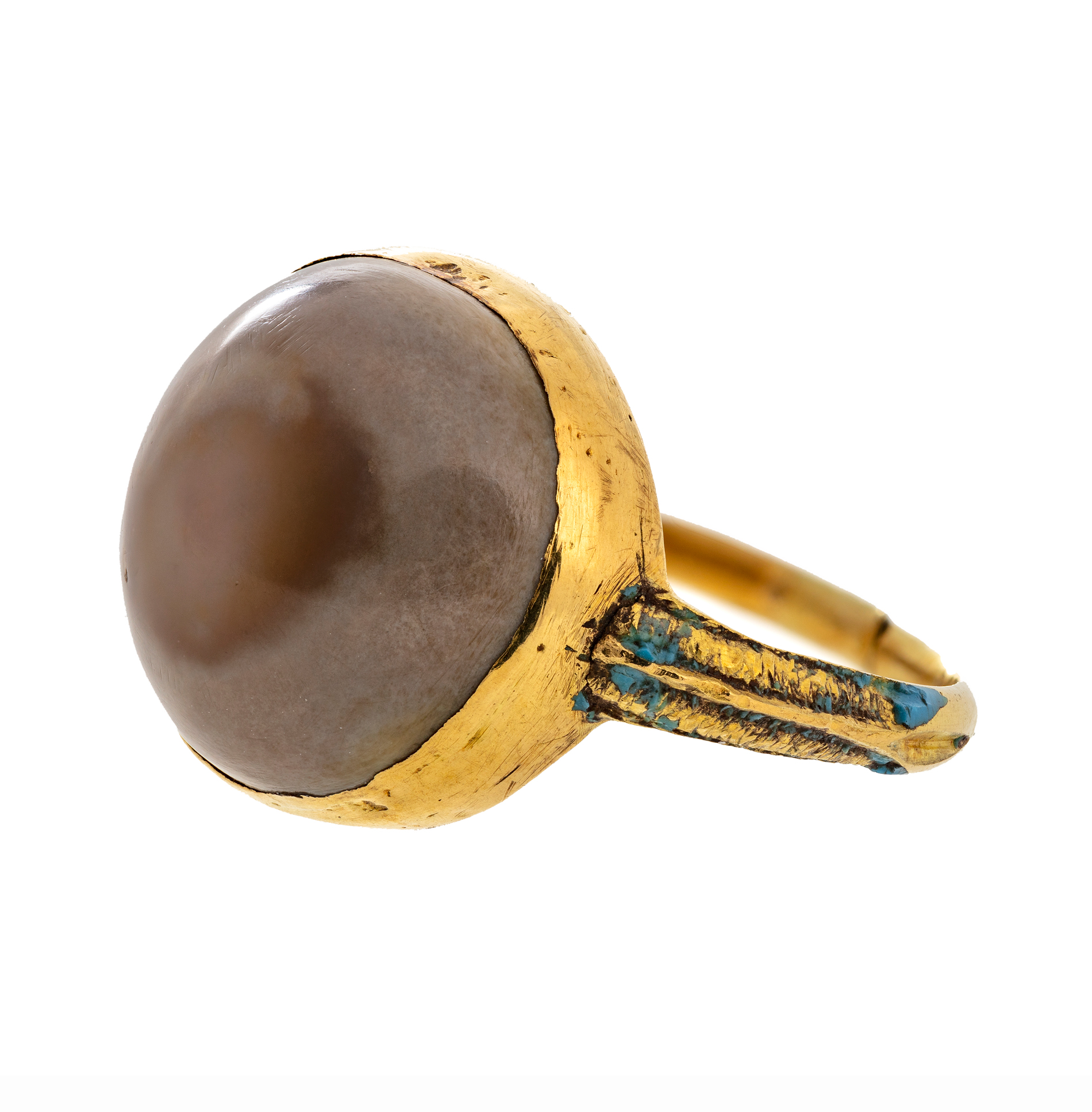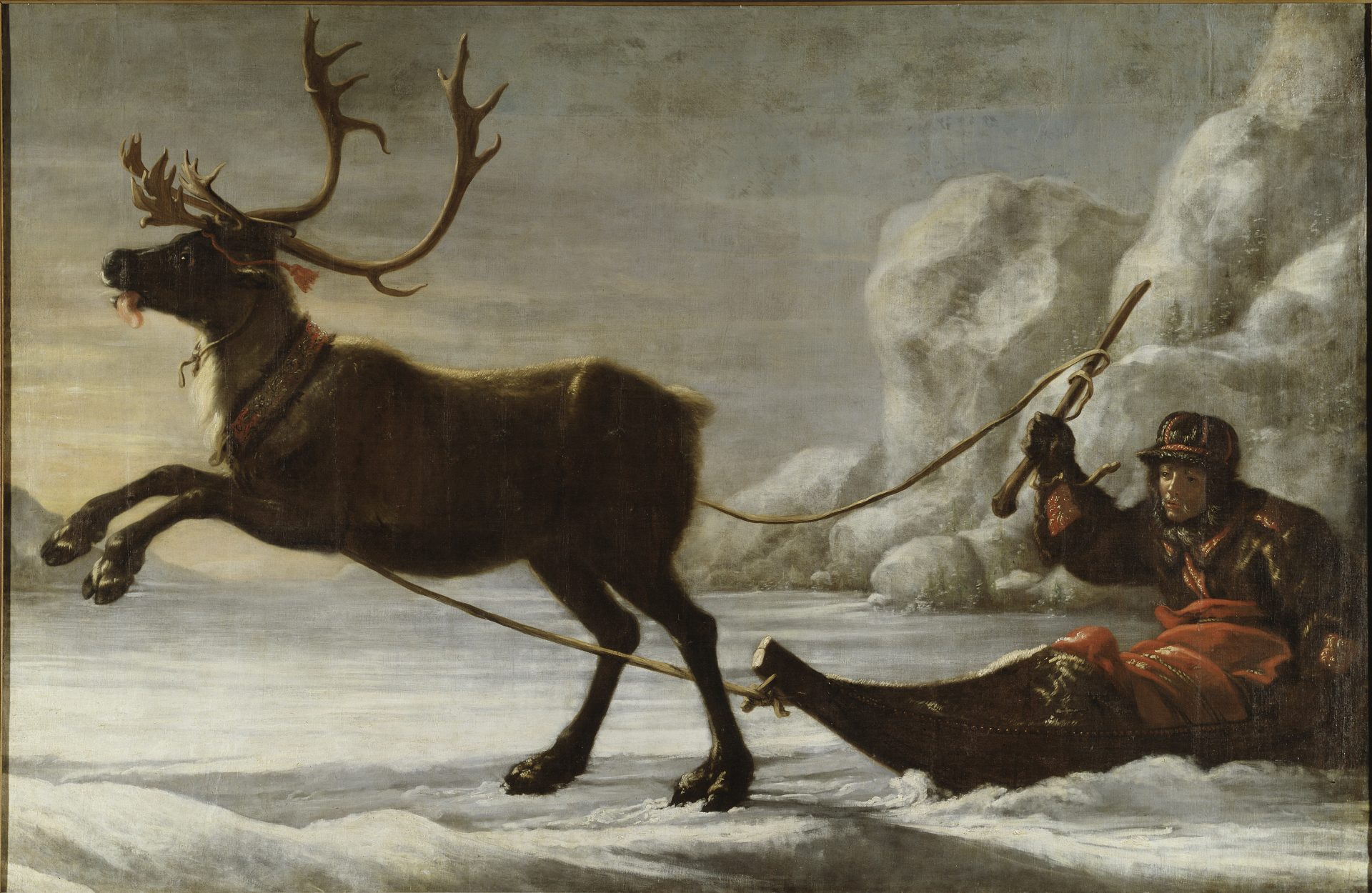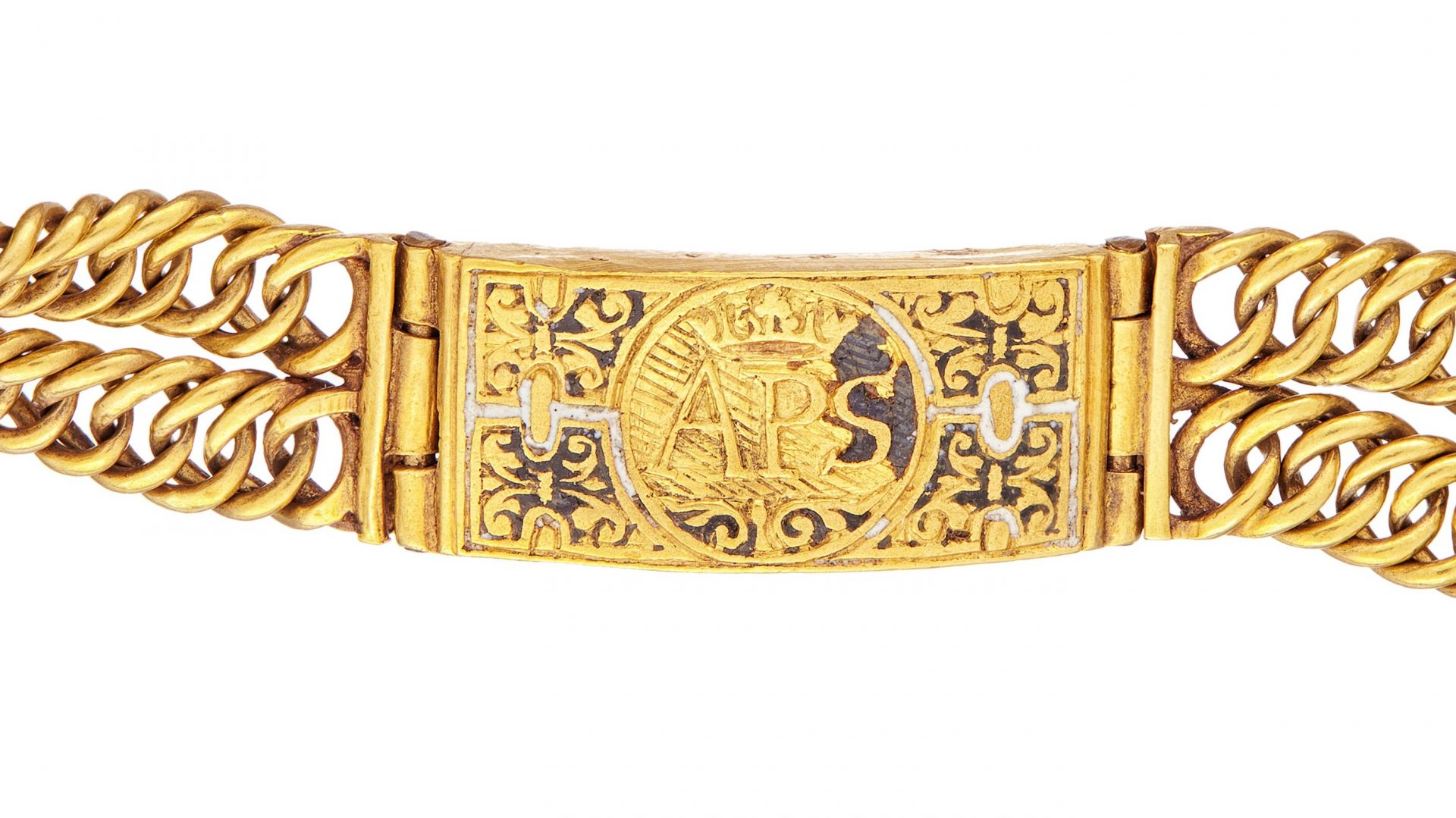
Royal Jewellery
The oldest object was made in the 1590s for Princess Anna of Sweden (1568–1625). Anna was the daughter of Johan III and his first wife, the Polish Princess Catherine Jagiellon. Anna spent long periods living with her court at Stegeborg Castle in Östergötland, but when her brother Sigismund became King of Poland, she followed him there.
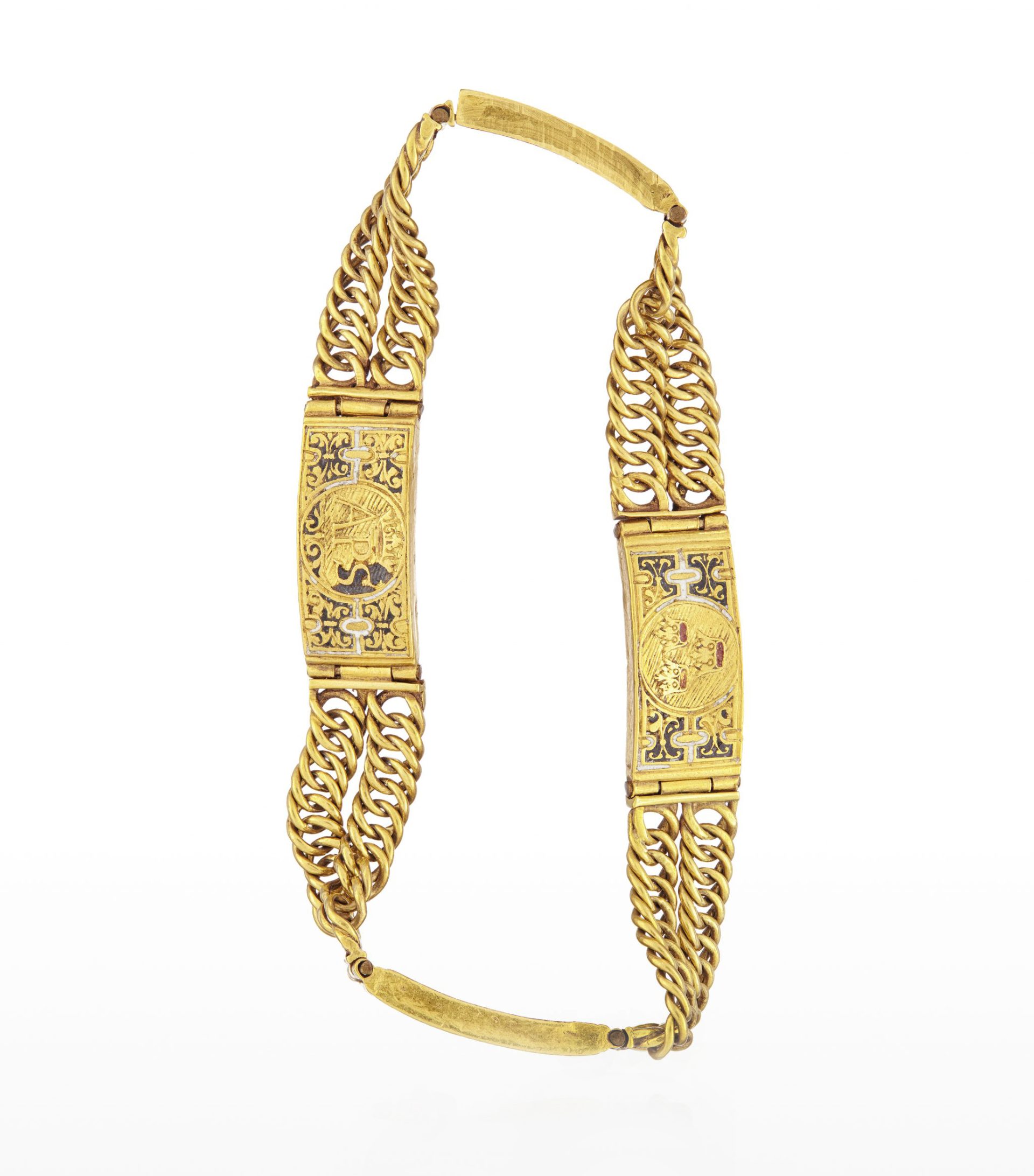
The bracelet is typical of its time, with pleated gold chains and panes covered with enamel in black, white and a hint of red. In this case, Anna’s initials APS (Anna Principessa Sveciae/Anna Princess of Sweden) are visible under an open crown on one of the panes. The other three panes show her family coat of arms with the vase, three crowns and the Folkunga lion.
Bracelets like this were always worn in pairs, although only one is preserved in the Royal Armoury’s collections. It is said to have been found in Uppsala Cathedral in 1777.
Karl IX’s coronation regalia
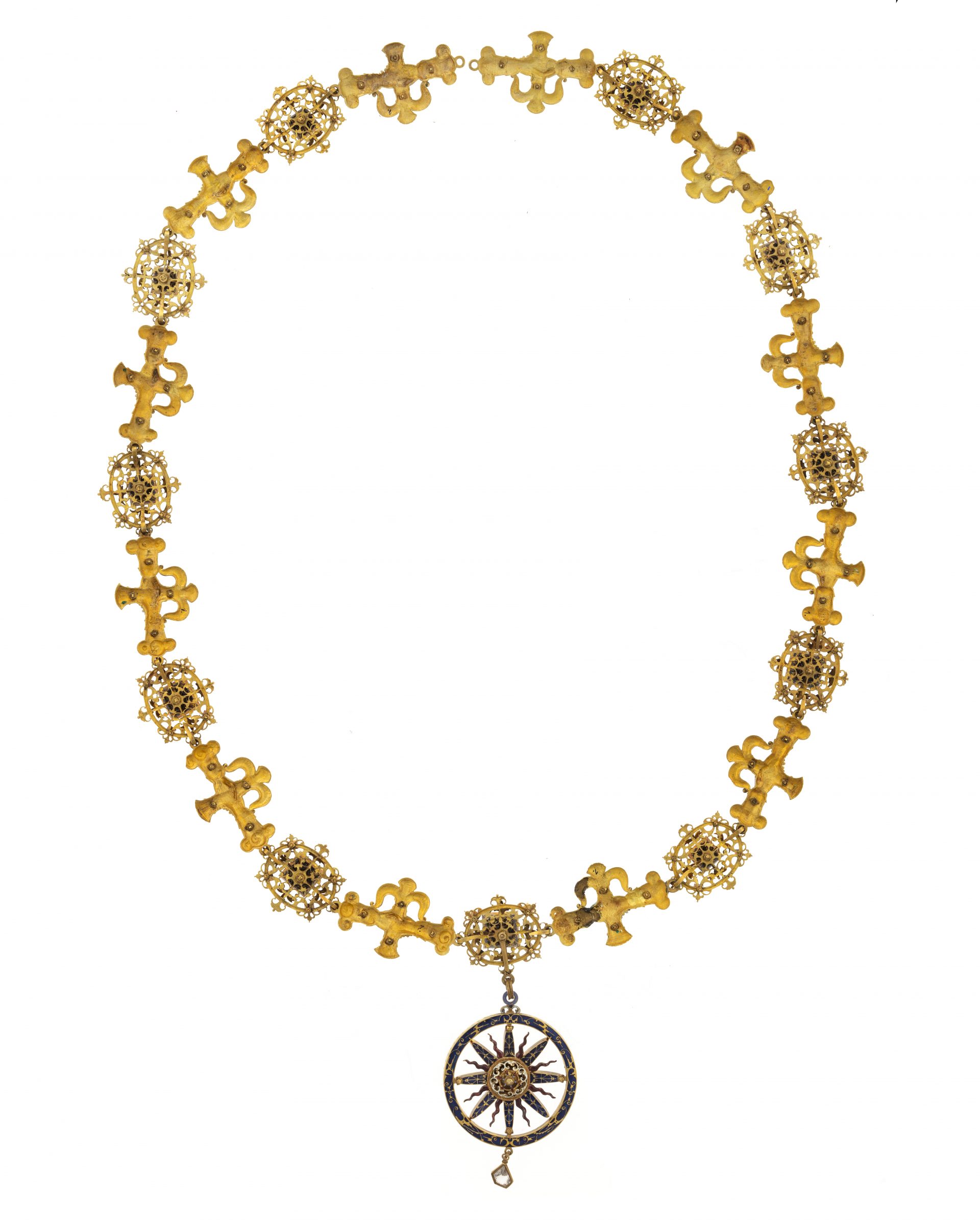
At Karl IX’s coronation in Uppsala Cathedral on 15 March 1607, no fewer than ten items of coronation regalia were used, two of which are now in the Royal Armoury: the Order of Jehovah (collar and badge of the order) and the coronation ring. The new, Protestant King wanted to surround his coronation with pomp and circumstance in order to consolidate his power against his nephew Sigismund and the Catholic interests that threatened his position and faith.
The Order of Jehovah was produced by Antonij Groot the Elder in Stockholm in 1606. The collar of the order consists of 23 links of gold and enamel. 11 of the links are inlaid with large, table-cut rock crystals and smaller garnets. 12 links represent a handshake, a male hand and a female hand that grasps a vase, the symbol of the House of Vasa. In the centre of the sun-shaped badge of the order is a large, octagonal rock crystal with Hebrew letters forming the word Jehovah in gold.
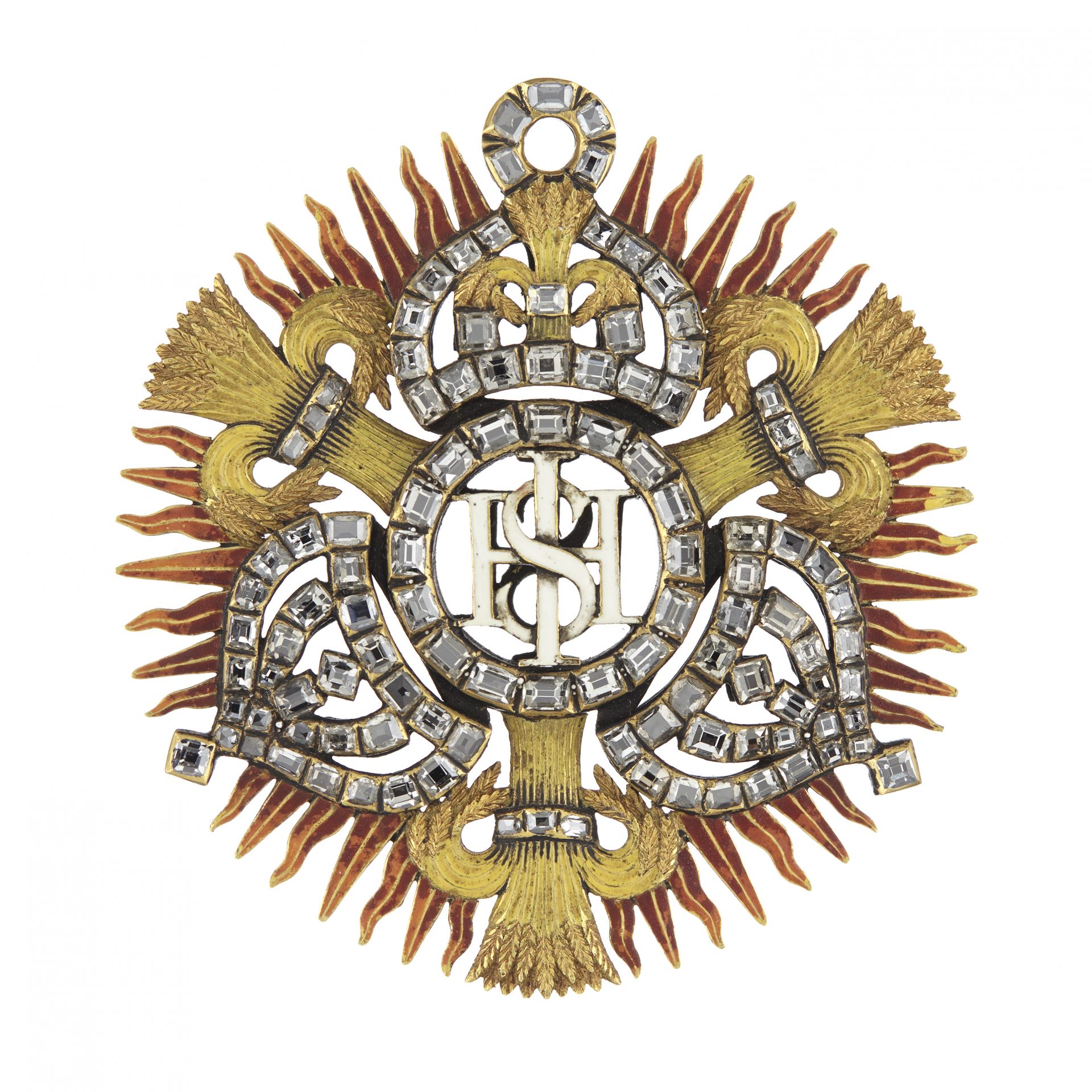
Johan Casimir’s wedding ring
Johan Casimir and Princess Catherine of Sweden, daughter of Karl IX and his first Queen Maria of the Palatinate, were married on 11 June 1615. This is evident from an inscription on the inside of the ring. The couple’s son, Karl Gustav, was appointed Swedish heir to the throne after his cousin, Queen Kristina, made it clear that she did not intend to marry. When Queen Kristina then abdicated, Sweden had a new royal dynasty.
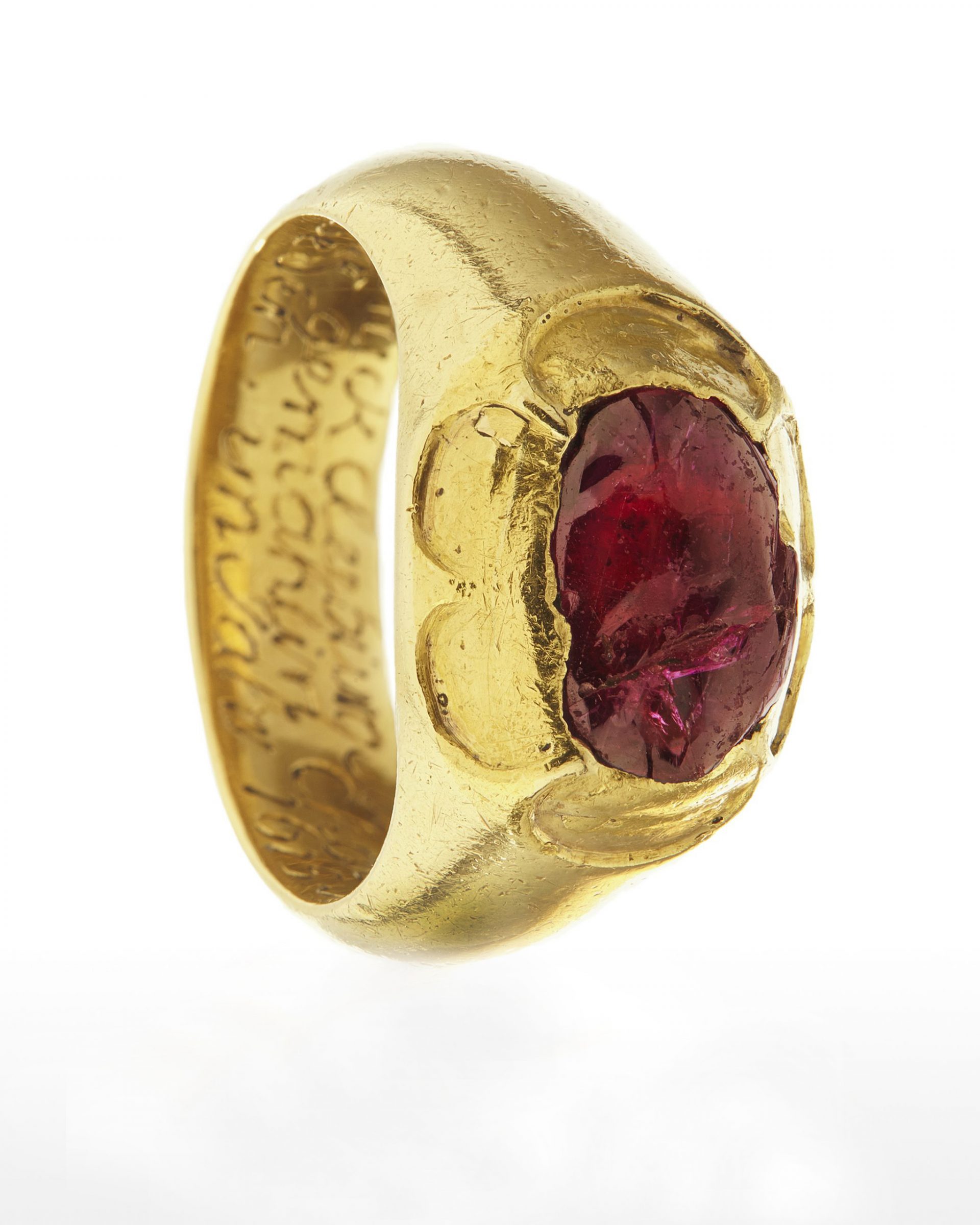
The wedding ring is made of gold with a ruby. The stone is cabochon cut, a technique that was common before it was possible to cut facets, but one that was also used later if a stone had any minor damage or defect. Cabochon cutting means that the top of the stone is convex, while the base is flat. The ruby is then set uncovered, i.e. in an enclosed form but with the hint of a claw. All in all, this means that the ruby does not reflect light to any great extent, which “kills” the stone.
Rubies are made from the mineral corundum. Red corundum is always known as ruby, while all other colours are called sapphire. The sapphire is usually associated with the colour blue, although this is not necessarily the case.
Queen Kristina’s signet ring
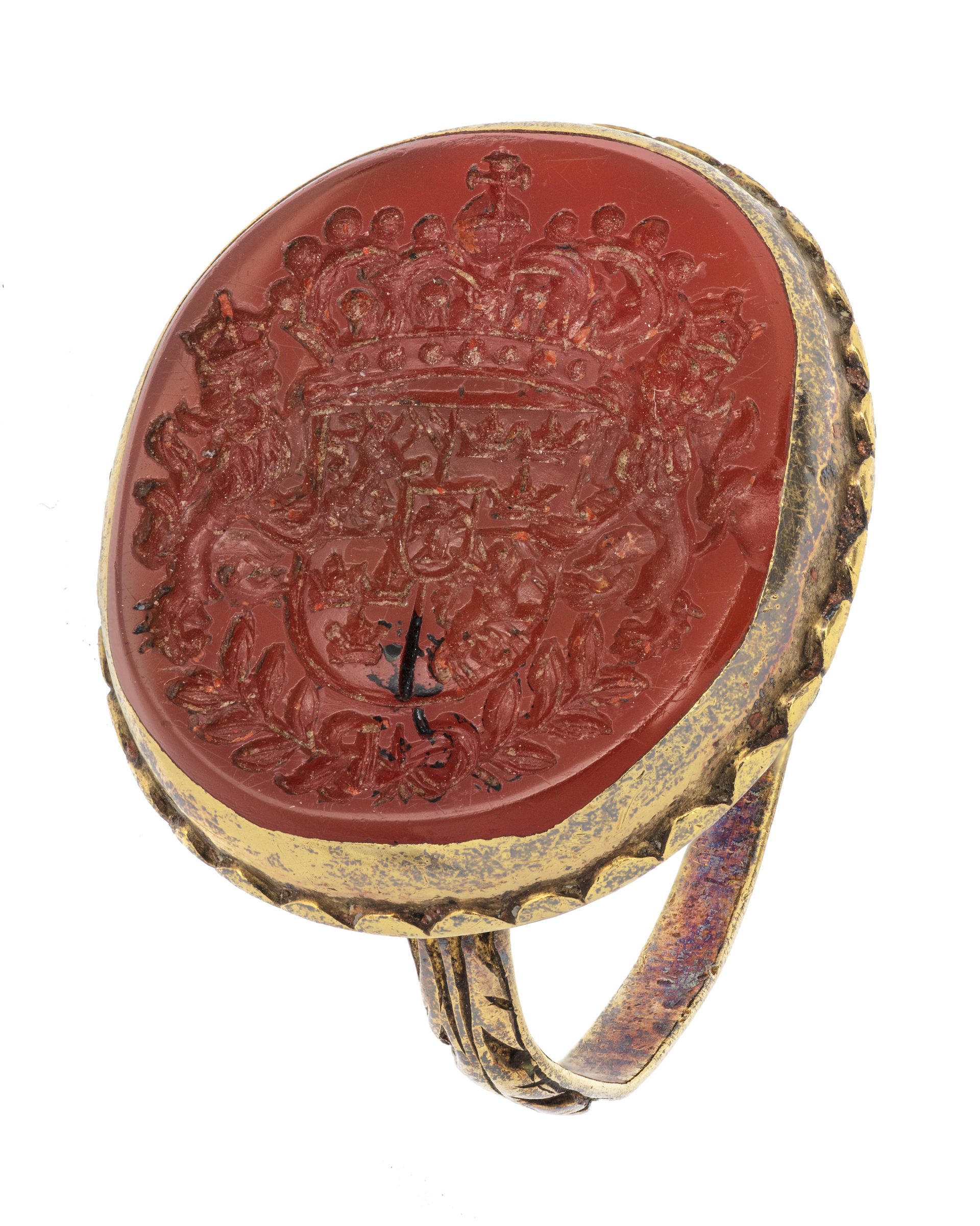
Queen Kristina was crowned in Stockholm Cathedral in 1650. It was probably in connection with this that she was given and started to use the signet ring.
The carnelian stone is engraved with the Swedish national coat of arms, with a vase in the heart shield. The monogram CR stands for Christina Regina/Queen Kristina. The gold ring band is very worn, and Kristina probably wore it every day. Maybe it even accompanied her to Rome after she had abdicated and converted?
Carnelian, like jasper and onyx, is a stone that was often used for signet rings and slightly heavier rings, especially for men.
Queen Hedvig Eleonora’s curative ring
Organic materials such as coral and amber were fashionable during the Baroque period, and it was popular to wear them as amulets to protect against disease and bad luck. According to a list from 1867, Hedvig Eleonora’s ring was adorned with a bezoar stone, although according to an exhibition catalogue from Nationalmuseum in 1930, it is an agate. It is, as we know now, a fossilised tooth from a pre-historic fish, some 200 million years old.
Hedvig Eleonora herself would have called it a toad stone, believed to have originated from a toad's head.
She was no doubt convinced that it had curative properties. The stone had to be in direct contact with the skin, so the stone is therefore set “à jour”. This means that the stone’s setting had an open base, which was unusual at the time. The ring has the remnants of enamel ornamentation on the ring band. “Hedvig Eleonora Regina Sueciae” is engraved on the underside. The ring band has been cut. Maybe the Queen’s fingers increased in size over the years?

Hedvig Eleonora lived a long life. She experienced the Palatinate Dynasty almost from beginning to end. In 1654, she was married to Karl X Gustav, the same year that the young Count Palatine first ascended the Swedish throne. She was taken to her final resting place in 1715, just a few years before her granddaughter Ulrika Eleonora the Younger abdicated.
Miniature portrait of Karl XI
This miniature portrait from about 1675–1680 depicts Karl XI. He was the son of Karl X Gustav and Queen Hedvig Eleonora of Holstein-Gottorp, and became King at the tender age of four. One of the King’s most important duties was to protect his country from internal and external enemies. Karl XI spent much of his adult life in the field, and he renewed the army.
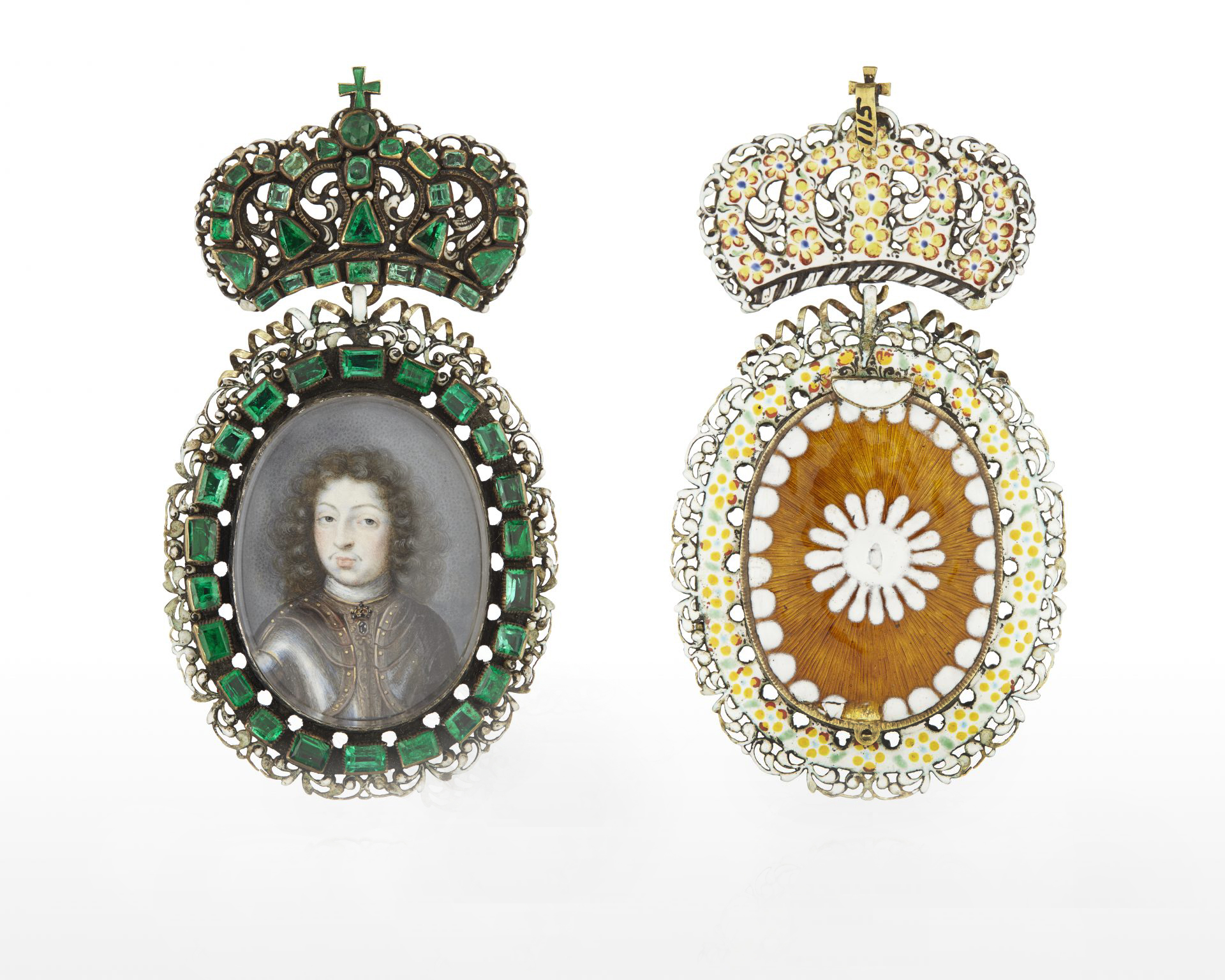
The miniature portrait depicts him wearing armour. The portrait is thought to have been painted by the Frenchman Pierre Signac. He and the Englishman Alexander Cooper were the first painters of miniatures in Sweden. They came to Queen Kristina’s court in 1647 on the advice of the Swedish Ambassador to Paris, Magnus Gabriel de la Gardie.
The frame consists of enamelled gold and silver, as well as several table-cut emeralds. Table-cutting is the earliest form of facet cutting. So-called emerald cutting was developed later, a rectangular shape with faceted corners. Without sharp corners, the fragile emerald is less vulnerable to bumps and blows.
Despite his rather simple manner, Karl XI understood the value of a magnificent piece of jewellery bearing the portrait of the King. Receiving such a piece of jewellery was proof of grace and was given above all to high-ranking ladies at court. A gold clasp on the reverse side makes it possible to wear on clothing. This beautiful and precious piece of jewellery might have belonged to the King’s wife, Queen Ulrika Eleonora the Elder of Denmark, or his mother.
Carolus signet ring
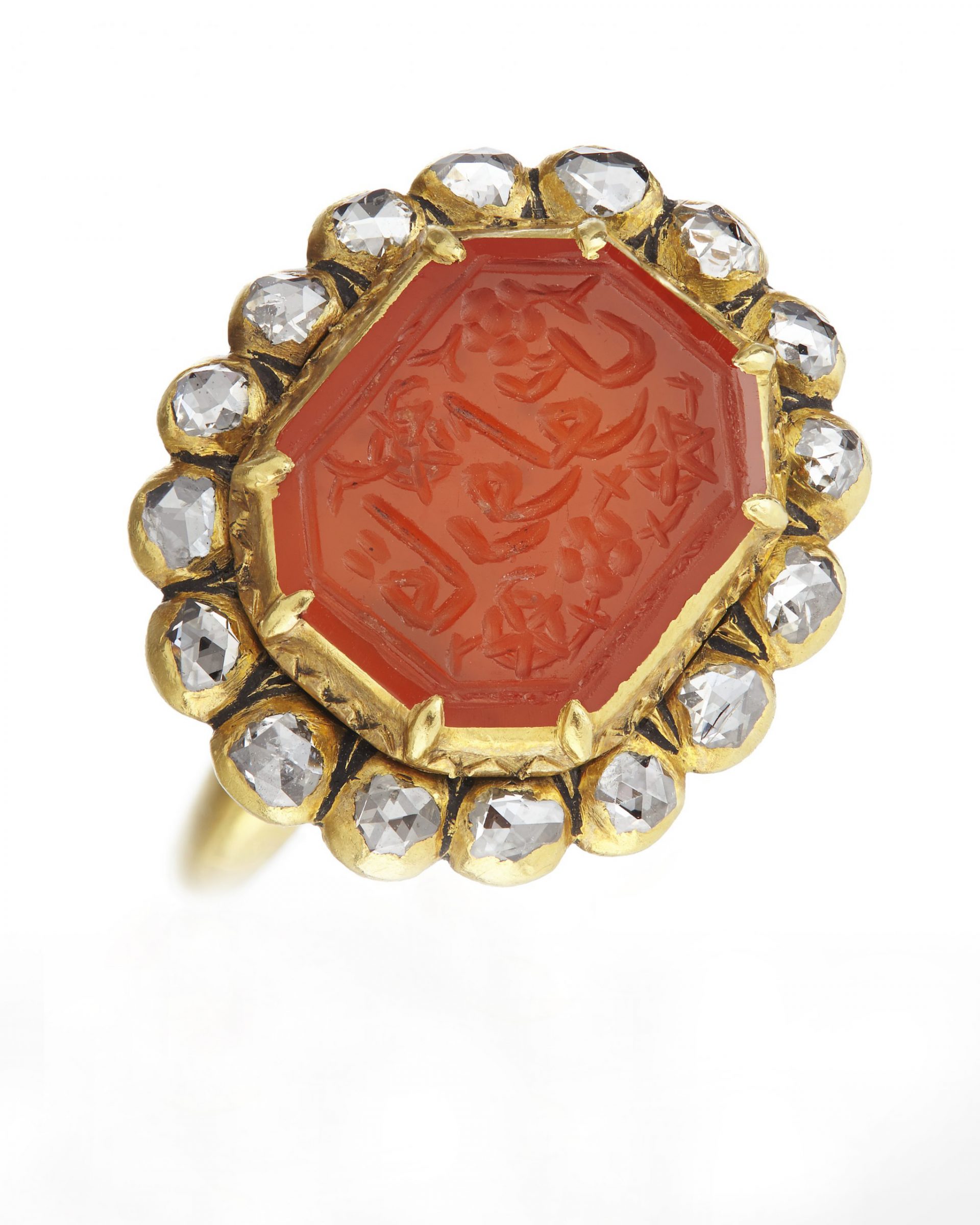
One of the more unusual rings in the Royal Armoury’s collection is a beautiful child-sized signet ring, made of gold with an octagonal carnelian. The ring has a rather awkward inscription of the name Carolus in Arabic. The carnelian is surrounded by rosettes, diamonds cut with triangular facets. The rosettes in Karl XI’s signet ring are made in the oldest type of setting, coffin-setting, which encloses both the sides of the stone and the base. The carnelian is uncovered.

The origins of the ring are unknown. It is presumably a gift to either Kalr XI or Karl XII. Karl XI’s grandparents from the Duchy of Holstein-Gottorp had sent missions to Persia back in the 1630s. When Karl XI was born, they sent gifts to the little prince.
Perhaps the ring, with its Arabic inscription, was purchased as a birth gift during trips to Persia? As an adult, Karl XI himself sponsored three trips to Persia in the 1670s and 1680s. These trips were led by explorer Ludvig Fabricius. One of the purposes of these expeditions was to create a new route for the silk trade. Another was to bring back gemstones. It is also possible that Fabricius brought the ring back as a gift to Karl XI’s little son Karl, later to become Karl XII.
Karl XII's pocket watch
At the age of 15, Karl XII became King of Sweden, and his reign was to be characterised by war. The pocket watch is possibly a gift to the victorious King after the Battle of Narva, on 20 November 1700, from his proud grandmother Hedvig Eleonora.
Watches were status symbols and worn as jewellery, preferably in combination with a chain (chatelaine) with a watch key. The watch is of the highest quality, manufactured in London, the heart of European pocket watch manufacturing. The watch is signed by the French watchmaker J. Bellete.
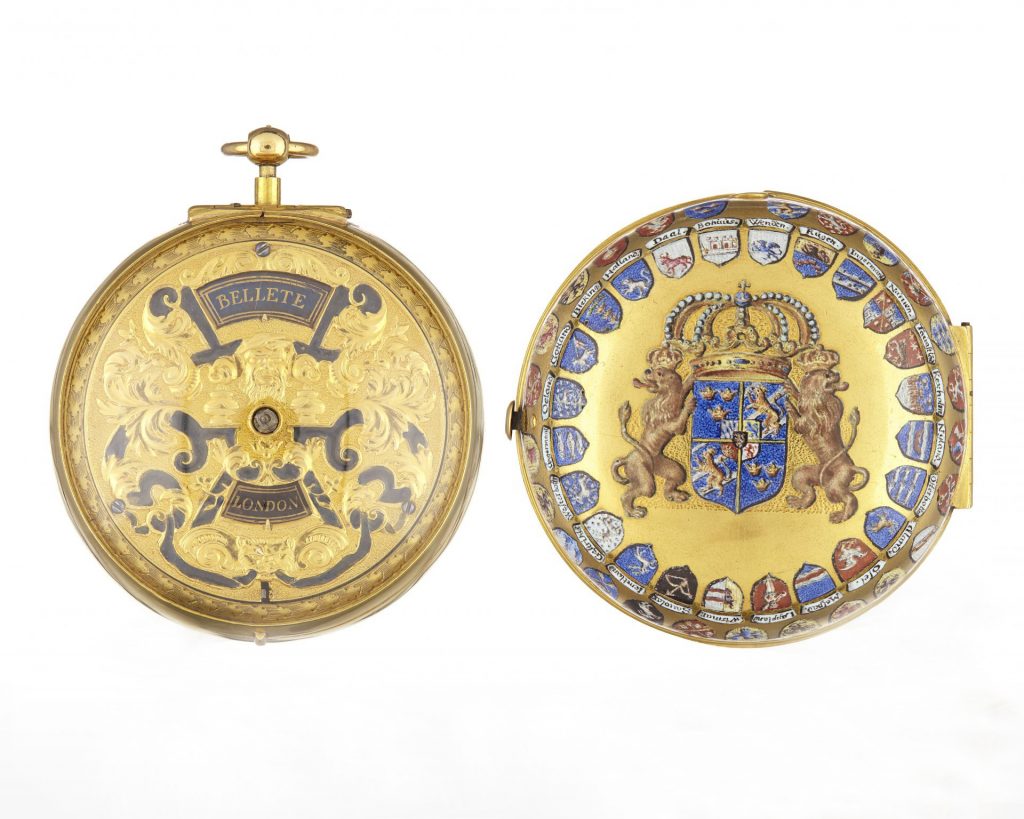
Karl XII’s clock is a peephole clock with an hour and minute pane respectively. The clockwork is that of a spindle clock. On the round upper pane, a pierced mirror monogram appears under the royal crown with the Latin dedication Carolvs duodecimus vivat floreat trivmphat (Karl XII, may he live, flourish, triumph).
The gold outer case, made by an anonymous blacksmith, is decorated with enamel. The Swedish national coat of arms and the House of Palatinate’s coat of arms in the middle. Around them, the 49 regions and provinces that then belonged to the Swedish superpower: Swedish and Finnish provinces, as well as possessions in the Baltic region, Poland and Germany.
The watch was missing for about 30 years after a theft. The associated chain and key are still missing, but the watch appeared on the international market, and in 1999 it was possible to buy it back for the Royal Armoury’s collections thanks to generous external contributions.
Drottning Lovisa Ulrika's ring
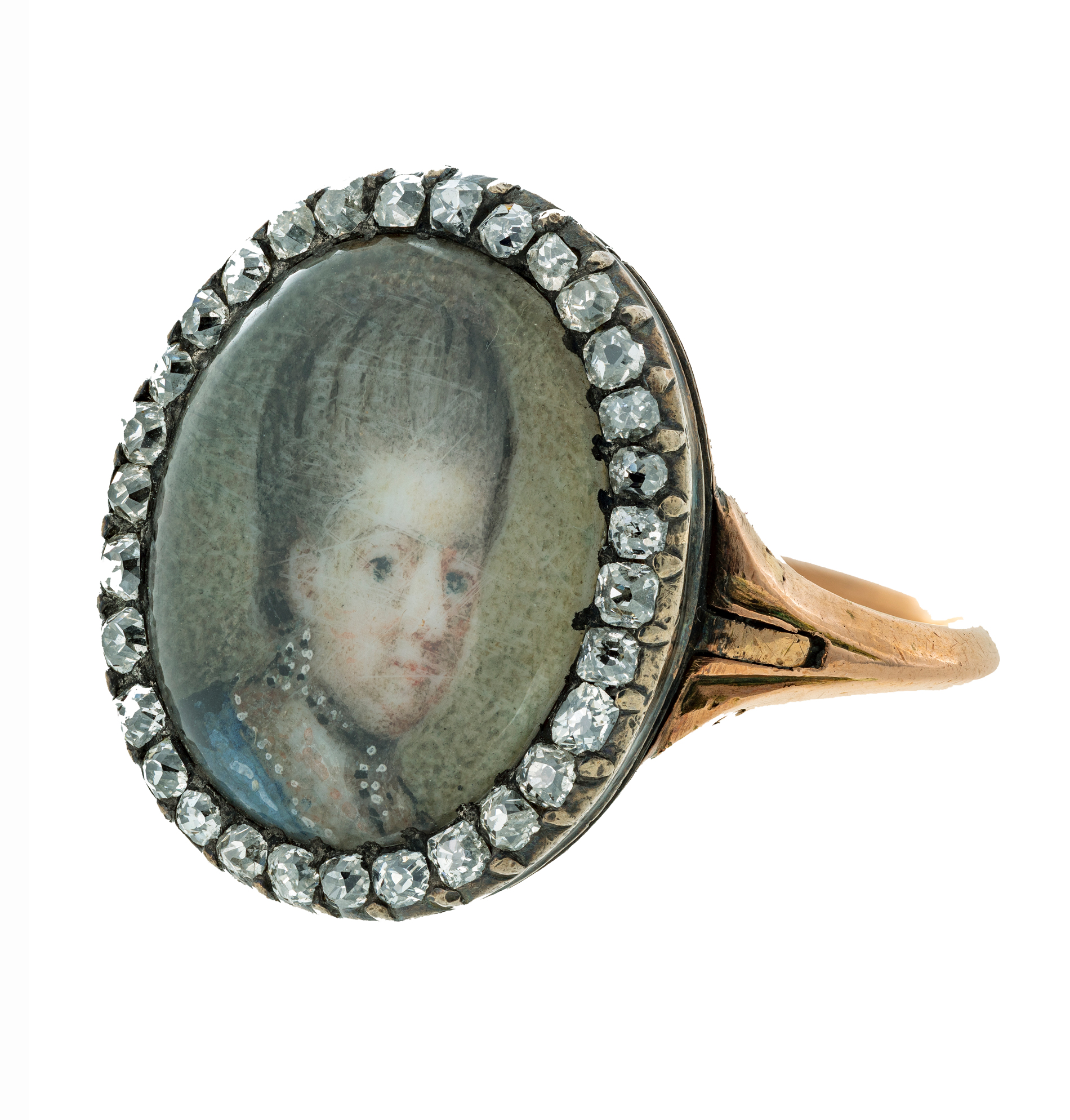
Queen Louisa Ulrika was Princess of Prussia. She brought a passion for all things French with her to the Swedish court. France was also a pioneer in the art of jewellery. For Louisa Ulrika’s coronation, a new crown was produced in a French style, in diamonds only. She later secretly switched all the diamonds for rock crystal in order to fund her attempted coup d’état. When the coup, which had aimed to strengthen the power of the monarchy, failed, the crown was restored.
The ring’s miniature portrait by Anton Ulrik Berndes depicts the Queen with diamond jewellery, earrings with drops and a short necklace with a pendant. The miniature portrait is also framed by diamonds.
Diamond cutting is said to have been invented in Venice. Old diamond cuts have 58 facets, compared to the modern version with 57 facets. In the past, they found it difficult to achieve perfection in the culet, the pointed underside of the stone, so they preferred to make an extra facet. This can be seen as a small black dot at the base of the stone, as on Louisa Ulrika’s ring.
Diamond cutting helped to reflect light and therefore became very attractive during the Rococo period because of its beautiful lustre. To enhance the effect even more, a piece of foil could be inserted behind the stones.
Gustav III’s revolution ring
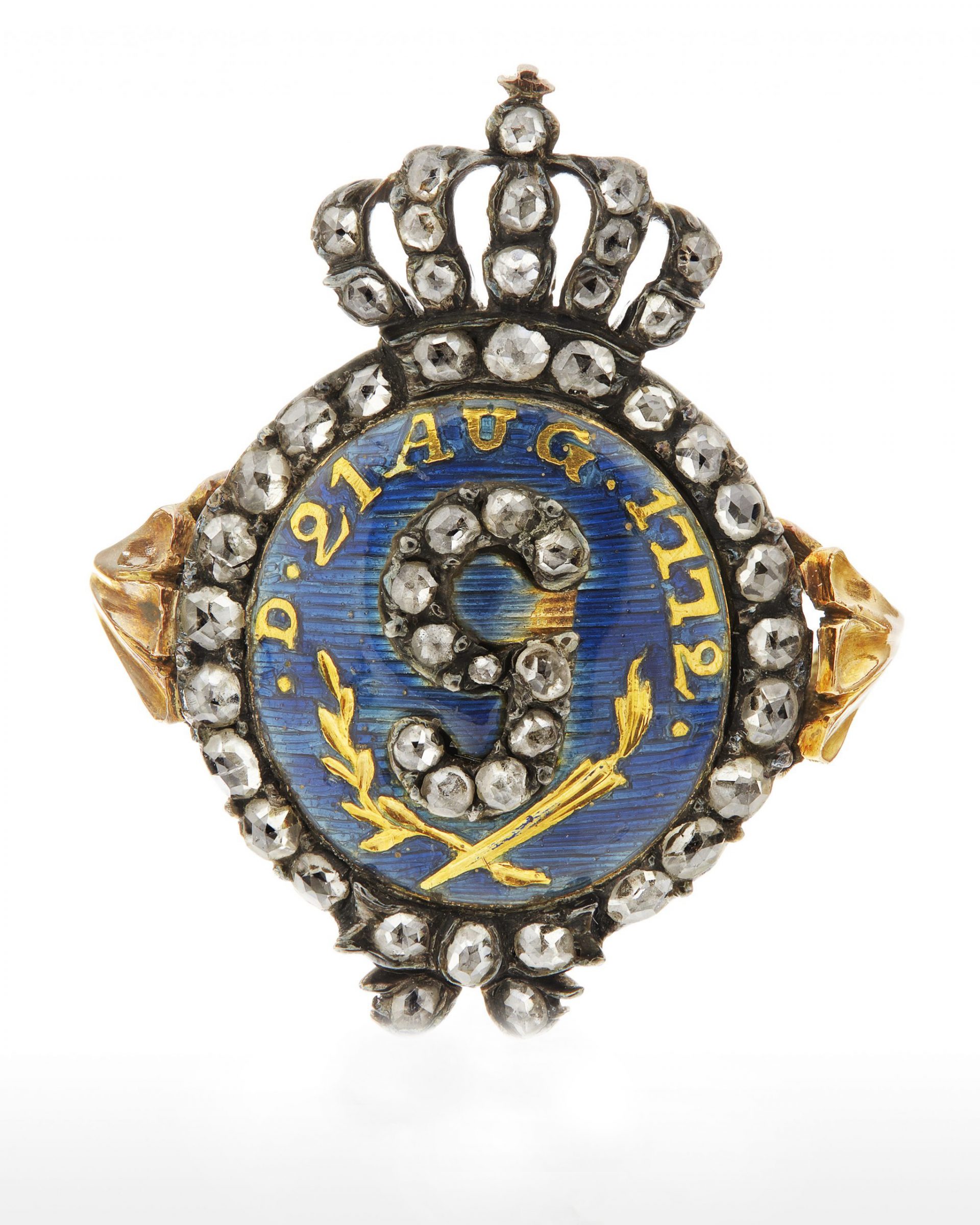
There were many versions of Gustav III’s revolution rings. This ring is one of the more exclusive versions of Gustav III’s revolution rings, in gold and dark blue enamel with a frame, and the King’s crowned monogram in rosettes. Under the monogram is a layer of twigs and a burning torch. Tradition has it that this ring was a gift to Johan Henrik Kröger, a student and dance teacher. Given the lavish design, it is possible that Kröger was one of the King’s confidants during the revolution.
In the 18th century, white metals were increasingly being used when setting of the fashionable gems of the time, diamonds. Even though the underside and ring band in this case are made of gold, the stones are made of silver so as not to turn yellow and lose their shine. New techniques at the setting, such as claws and grains or an open reverse side, an “à jour” setting, also allowed more light to reach the stones.
The Queen's demi-parure
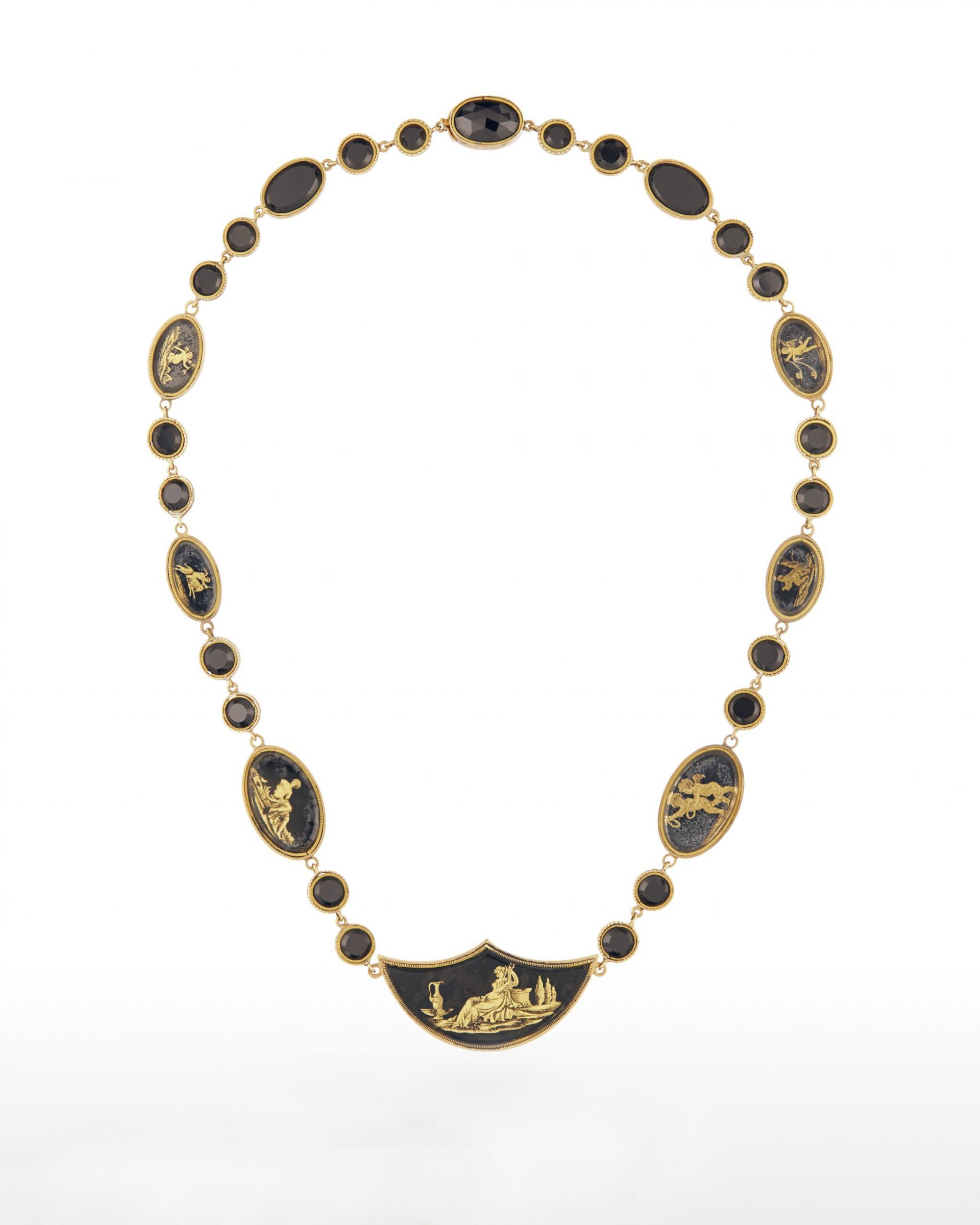
An early demi-parure (small set of jewellery) in Empire style. The Empire style was inspired by antiquity. Queen Frederica’s necklace and earrings in glass, gold and onyx have motifs that are intended to resemble those of antiquity.
The Queen was exiled with her family in 1809 and forced, in a humiliating way, to be separated from most of her jewellery.
The jewellery had been laid out on a table at Gripsholm Castle, and the King and Queen had to indicate which items of jewellery they felt belonged to them privately.
Despite this, the Queen donated this small set of jewellery to her chambermaid upon her departure from Sweden. Somehow, the jewellery found its way to the new royal family. The small set of jewellery was later used by Queen Josephine, who also replaced the lock of the necklace in the 1830s. The lock was manufactured by Anders Petter Lundqvist in Stockholm.
Queen Josephine’s filigree parure
Josephine of Leuchtenberg was only 16 years old when she married the Swedish Crown Prince Oscar. As a dowry, she brought with her several large sets of jewellery, parures, that had belonged to her grandmother, Empress Joséphine: the cameo parure and the sapphire parure that the Swedish royal family likes to wear at weddings and Nobel festivities, as well as the emerald parure that the grandmother wore at her and husband Napoleon I’s coronation. This parure now belongs to the Norwegian royal family.
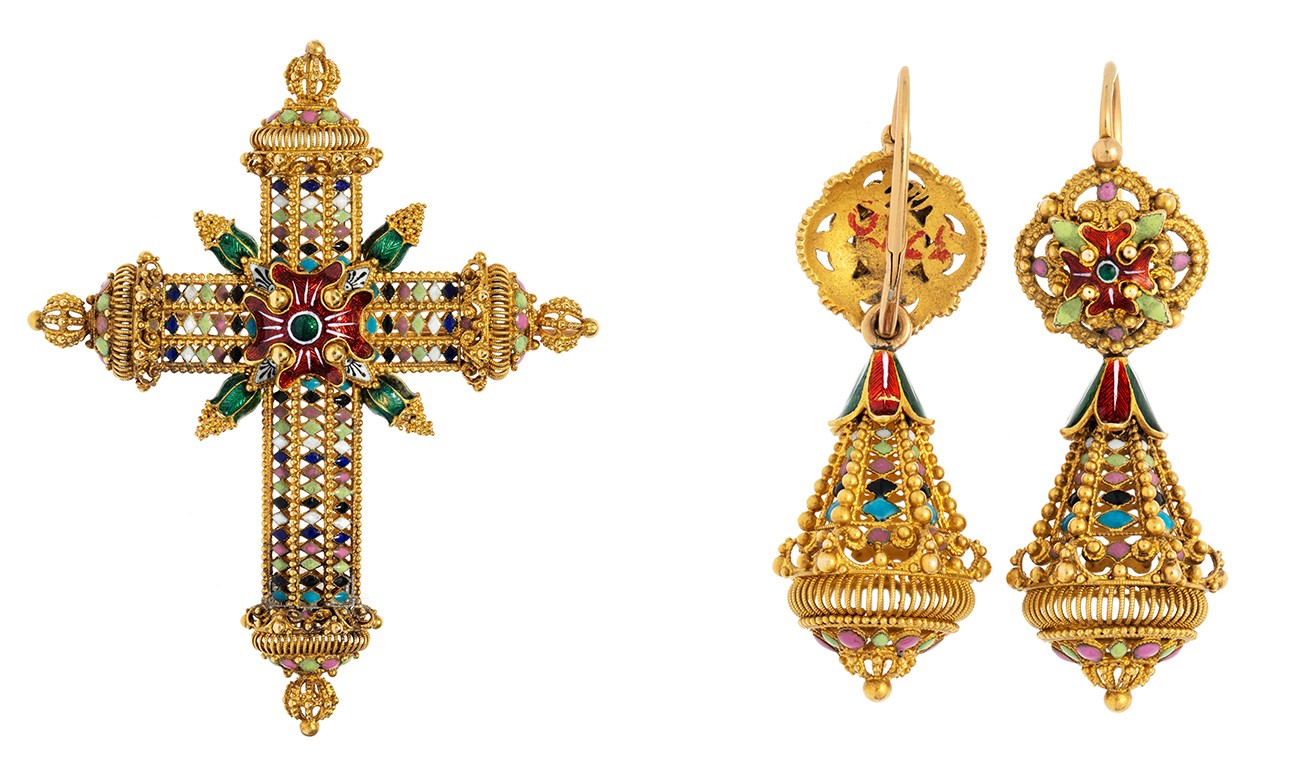
Josephine also owned simpler sets of jewellery, demi-parures, like this brooch in the form of a cross with matching gold filigree earrings and polychrome enamel. This fashion came from the ladies of the bourgeoisie, who, with the major social changes of the 19th century, had also started to wear jewellery. They liked to wear parures because they were so practical. Large sets of jewellery could often be combined and varied. A diadem or two bracelets could become a necklace, a brooch could become a pendant, and so on.
For reasons of cost, they used simpler gems and a little gold. Different types of our most common mineral, quartz, amethyst and citrine, were widely used. In order to achieve the greatest possible impact from the minimum amount of gold, the gold was rolled into large panels or drawn into long threads, as in Josephine’s filigree parure.
Oscar I’s tie pin
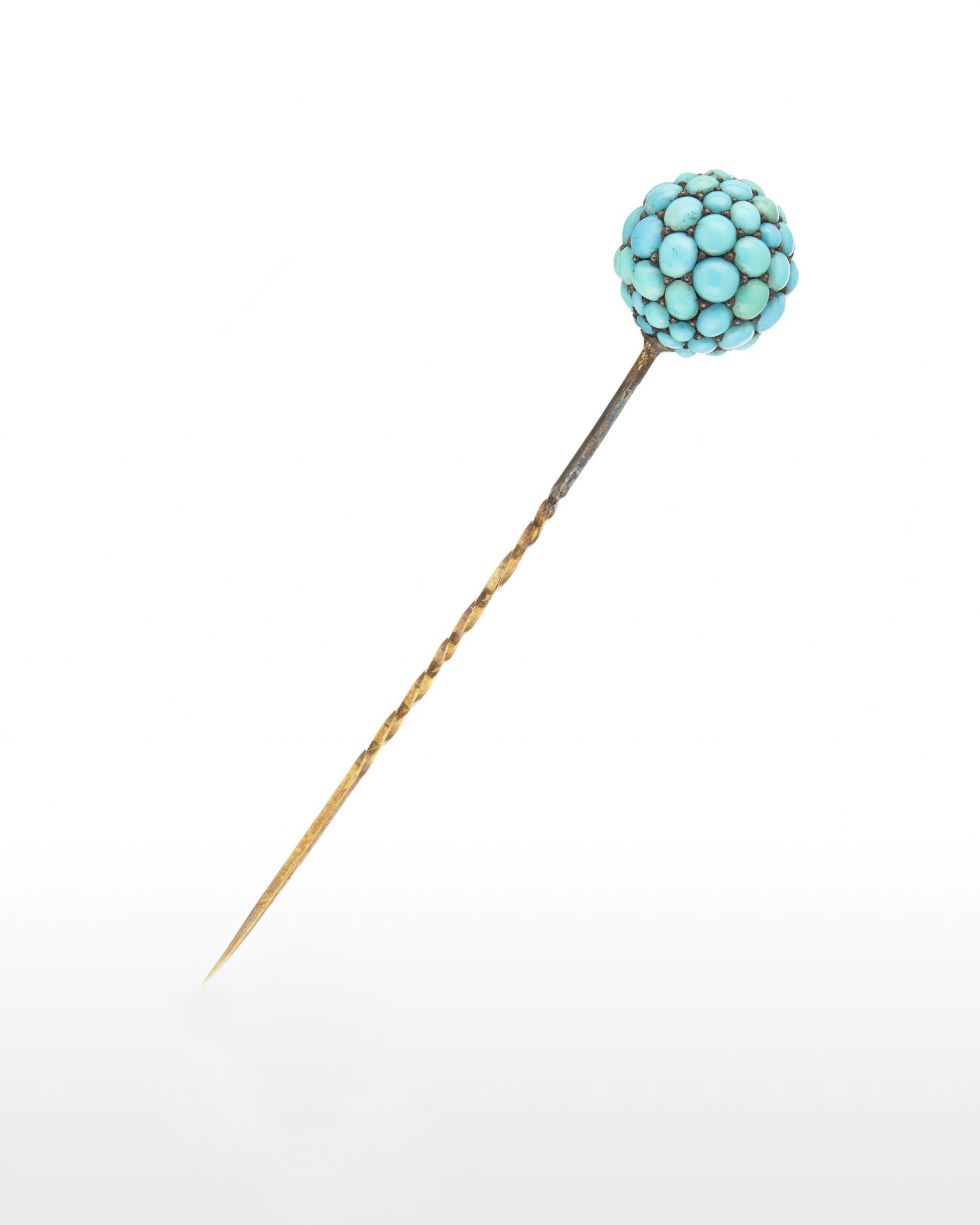
When the bourgeoisie started to wear jewellery, production was adapted to meet their needs. Pocket watches, watch chains, tie pins and cufflinks became common items of male jewellery throughout the 19th and 20th centuries. This bourgeois fashion also reached the Swedish royal family.
Oscar I’s tie pin is made of relatively simple materials, with a gold pin and a silver globe-shaped head covered with dots of turquoise blue enamel. This may have been meant to resemble turquoise stones. Previously, less hard stones were referred to as semi-precious stones. That terminology is no longer used, although it does indicate that those stones were seen as a less exclusive material.
The tie pin is a gift to the museum from the King’s daughter, Princess Eugénie. The Princess inherited several pieces of jewellery from her parents. Some she gave away, a few she kept, but she sold most of them to fund her philanthropic activities.

